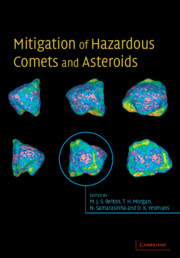Book contents
- Frontmatter
- Contents
- List of contributors
- Preface
- Acknowledgments
- Glossary
- 1 Recent progress in interpreting the nature of the near-Earth object population
- 2 Earth impactors: orbital characteristics and warning times
- 3 The role of radar in predicting and preventing asteroid and comet collisions with Earth
- 4 Interior structures for asteroids and cometary nuclei
- 5 What we know and don't know about surfaces of potentially hazardous small bodies
- 6 About deflecting asteroids and comets
- 7 Scientific requirements for understanding the near-Earth asteroid population
- 8 Physical properties of comets and asteroids inferred from fireball observations
- 9 Mitigation technologies and their requirements
- 10 Peering inside near-Earth objects with radio tomography
- 11 Seismological investigation of asteroid and comet interiors
- 12 Lander and penetrator science for near-Earth object mitigation studies
- 13 Optimal interception and deflection of Earth-approaching asteroids using low-thrust electric propulsion
- 14 Close proximity operations at small bodies: orbiting, hovering, and hopping
- 15 Mission operations in low-gravity regolith and dust
- 16 Impacts and the public: communicating the nature of the impact hazard
- 17 Towards a national program to remove the threat of hazardous NEOs
- Index
4 - Interior structures for asteroids and cometary nuclei
Published online by Cambridge University Press: 12 October 2009
- Frontmatter
- Contents
- List of contributors
- Preface
- Acknowledgments
- Glossary
- 1 Recent progress in interpreting the nature of the near-Earth object population
- 2 Earth impactors: orbital characteristics and warning times
- 3 The role of radar in predicting and preventing asteroid and comet collisions with Earth
- 4 Interior structures for asteroids and cometary nuclei
- 5 What we know and don't know about surfaces of potentially hazardous small bodies
- 6 About deflecting asteroids and comets
- 7 Scientific requirements for understanding the near-Earth asteroid population
- 8 Physical properties of comets and asteroids inferred from fireball observations
- 9 Mitigation technologies and their requirements
- 10 Peering inside near-Earth objects with radio tomography
- 11 Seismological investigation of asteroid and comet interiors
- 12 Lander and penetrator science for near-Earth object mitigation studies
- 13 Optimal interception and deflection of Earth-approaching asteroids using low-thrust electric propulsion
- 14 Close proximity operations at small bodies: orbiting, hovering, and hopping
- 15 Mission operations in low-gravity regolith and dust
- 16 Impacts and the public: communicating the nature of the impact hazard
- 17 Towards a national program to remove the threat of hazardous NEOs
- Index
Summary
Introduction
Mitigation of any hazard begins with a comprehensive understanding of the forces to be reckoned with. Reckoning – taking measure – is being done with great efficiency on one front: the first-order census of kilometer-scale near-Earth objects (NEOs) may be complete in the next few decades (Jedicke et al. 2003). But the most basic physical properties of these bodies remain unknown: how they are assembled, how they respond to tidal and impact stress, and how they will respond to the artificial perturbations that will one day be required.
This chapter provides an introduction to comets and asteroids and their geophysical evolution, and concludes with recommendations for theoretical and laboratory effort and spacecraft reconnaissance. Little is known for sure. Comprehensive introductions to the rapidly evolving science of comets and asteroids are found in the University of Arizona Press review volumes Asteroids III (Bottke et al. 2002) and Comets II (Festou et al. 2004).
Comets
Not long ago, interplanetary space near Earth was believed to be far emptier than it now appears. The only luminous entities besides the Moon were the passing comets, whose comae and tails can form some of the most extensive structures in the solar system, and which have been scrutinized since the dawn of astronomy. While these centuries of observation have led to an understanding of the dynamics and compositions of cometary envelopes, cometary nuclei – compact objects ranging from a few hundreds of meters to a few hundreds of kilometers diameter – remain a tight-wrapped mystery (Jewitt 1999; Meech et al. 2004).
Information
- Type
- Chapter
- Information
- Mitigation of Hazardous Comets and Asteroids , pp. 66 - 103Publisher: Cambridge University PressPrint publication year: 2004
Accessibility standard: Unknown
Why this information is here
This section outlines the accessibility features of this content - including support for screen readers, full keyboard navigation and high-contrast display options. This may not be relevant for you.Accessibility Information
- 3
- Cited by
